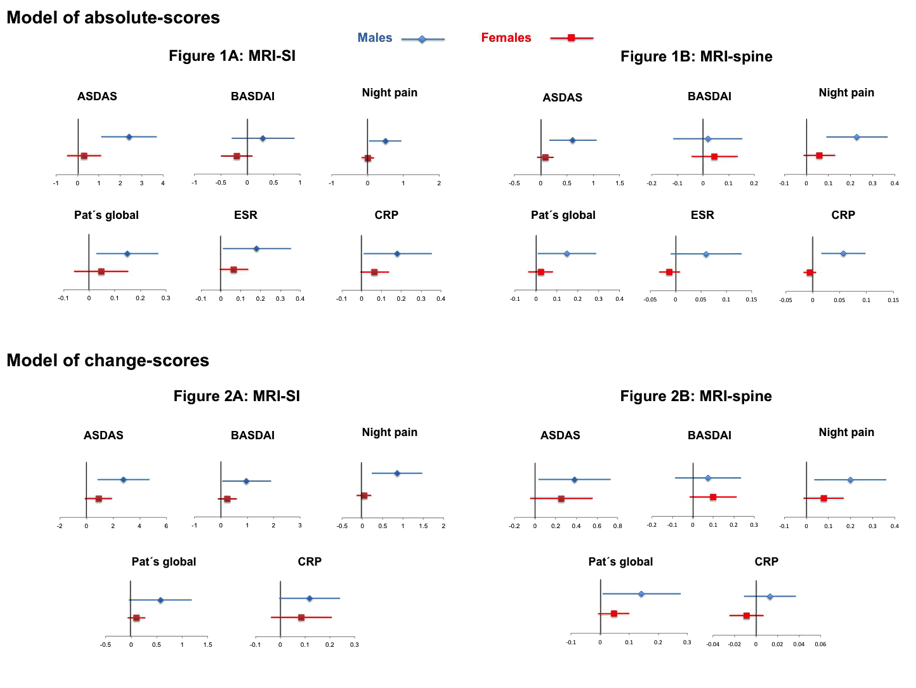Session Information
Session Type: ACR Concurrent Abstract Session
Session Time: 4:30PM-6:00PM
Background/Purpose: In patients with axial
spondyloarthritis (axSpA), clinical disease activity measures (DA) have been
longitudinally related to radiographic progression. Interestingly, a gender
disparity has been observed in this relationship, but the reason for this is
unclear. Here, we
investigate whether such a gender disparity also exists with respect to the
relationship between DA and inflammatory lesions on magnetic resonance imaging
(MRI) of the sacroiliac joints (SI) and the spine.
Methods: Two-year follow-up data from 167 patients fulfilling
ASAS axSpA criteria in the DESIR cohort with at least two MRIs of SI and/or spine
available during this period were analyzed. Baseline characteristics of
patients included were: 50% males, mean (SD) age: 33 (9) years, 81% HLA-27
positive and symptom duration: 18 (11) months. The association between inflammatory
lesions on MRI of SI/spine (measured by SPARCC/Berlin score, respectively) and
DA (ASDAS, BASDAI, patient«s global disease activity, night pain, CRP and ESR)
was investigated using generalized estimating equation (GEE) models: i) a model
of absolute-scores; and ii) a model of change-scores. All models were adjusted
for age, symptom duration and HLA-B27.
Results: The relationship between inflammatory lesions
on MRI and DA was different in males than in females. MRI-scores of SI/spine
(i) were statistically significantly associated to most of the DA in males, but
not in females (Figure 1A&1B). In the model of changes (ii), ASDAS was
significantly associated with inflammatory lesions on MRI of either SI (Fig 2A)
or spine (Fig 2B) in males, but not in females. Similar effects were seen
with different DA measures.
Conclusion: In male, but not in female patients with
axSpA, clinical disease activity is longitudinally associated with inflammatory
lesions on MRI. This observation supports the hypothesis that some aspects of axSpA
are different in males compared to females.
Figure:
Longitudinal
relationship between clinical disease activity measures and inflammation degree
(SPARCC/Berlin) on MRI-SI/spine stratified for gender. Markers and surrounding
lines represent beta values and 95%CI, respectively.
To cite this abstract in AMA style:
Navarro-Compán V, Ramiro S, Landewé RBM, Dougados M, Miceli-Richard C, Richette P, van der Heijde D. Inflammation on MRI in Sacroiliac-Joints and Spine Is Longitudinally Related to Disease Activity in Male but Not in Female Patients with Axial Spondyloarthritis: 2-Year Data from the DESIR Cohort [abstract]. Arthritis Rheumatol. 2015; 67 (suppl 10). https://acrabstracts.org/abstract/inflammation-on-mri-in-sacroiliac-joints-and-spine-is-longitudinally-related-to-disease-activity-in-male-but-not-in-female-patients-with-axial-spondyloarthritis-2-year-data-from-the-desir-cohort/. Accessed .« Back to 2015 ACR/ARHP Annual Meeting
ACR Meeting Abstracts - https://acrabstracts.org/abstract/inflammation-on-mri-in-sacroiliac-joints-and-spine-is-longitudinally-related-to-disease-activity-in-male-but-not-in-female-patients-with-axial-spondyloarthritis-2-year-data-from-the-desir-cohort/

